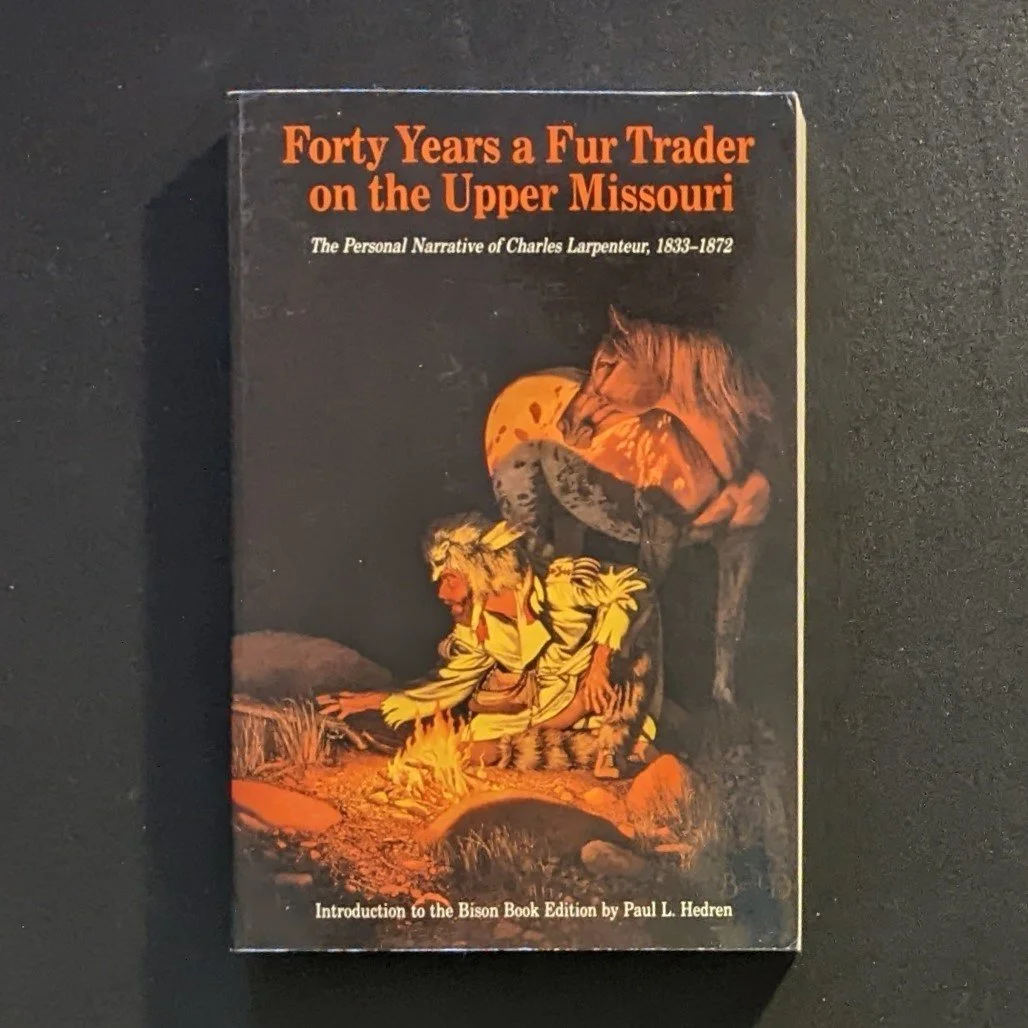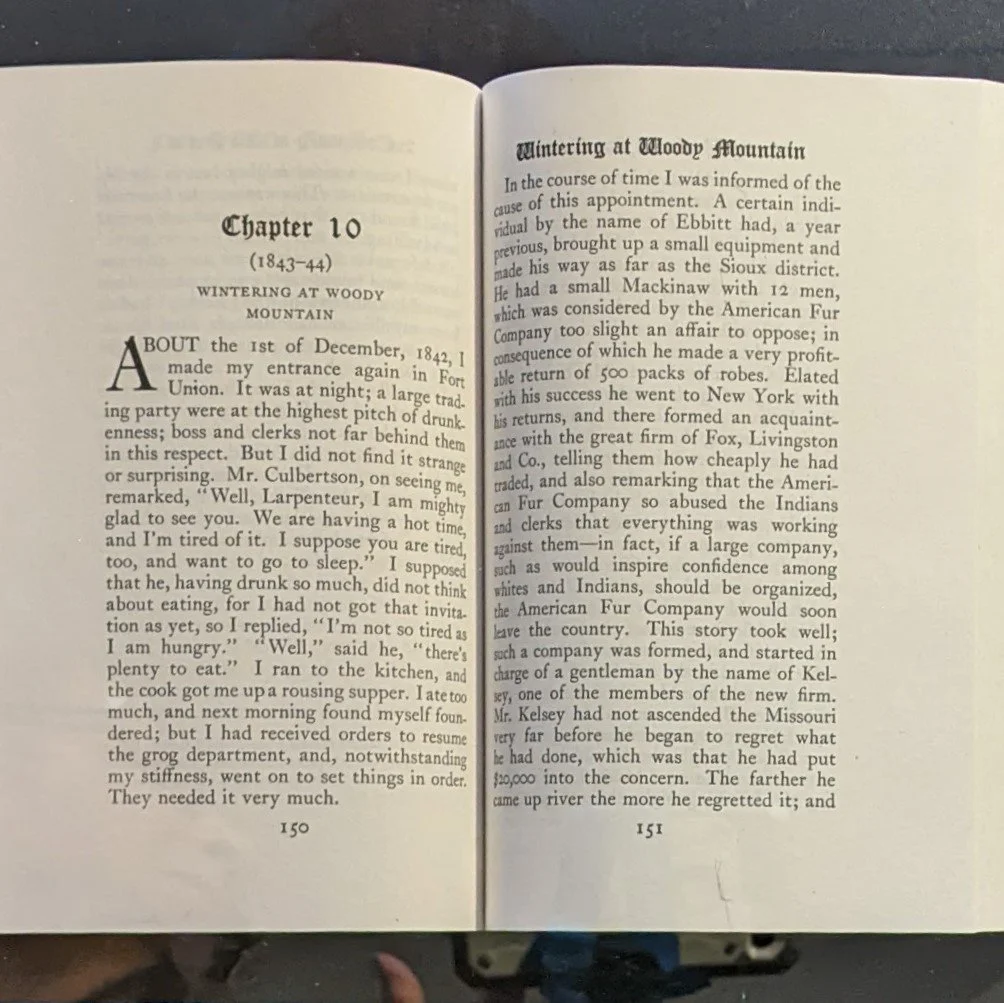 Image 1 of 3
Image 1 of 3

 Image 2 of 3
Image 2 of 3

 Image 3 of 3
Image 3 of 3




Forty Years a Fur Trader on the Upper Missouri: The Personal Narrative of Charles Larpenteur, 1833-1872
Forty Years a Fur Trader on the Upper Missouri: The Personal Narrative of Charles Larpenteur, 1833-1872.
Reprint of the orginal 1933 publication with historical introduction by Milo Milton Quaife and Bison Books introduction by Paul Hedren, National Park Service.
Larpenteur was born in France, five miles from Fontainebleau, in 1807. His father left France after the Battle of Waterloo, with others who believed that the Americans would rescue Napoleon from that island. When it became apparent that would not happen, he and the others by the King and returned to France. In 1818, he purchased a farm near Baltimore brought his family to America. Larpenteur went to St. Louis, having heard of the rich soils there. St. Louis was a far trek then and the growing hub of western expansion.
Based on his diary, Larpenteur describes how he is enticed to explore the upper Midwest and take on a position at Fort Union Trading Post. His account of the smallpox epidemic of 1937 is quite interesting. A boat arrived at the Fort Union with one survivor of smallpox aboard. The survivor had been vaccinated and since they had no vaccine, they decided to try inoculating 30 Indian women and a few white men with smallpox from the survivor, as outlined in Dr. Thomas’ medical book, to prevent the spread. The smallpox survivor, however, was unhealthy, and the experiment failed tragically.
And so it goes. The first hand account of fur trading and his relationships with the native Indians is an important source of information.
Paperback - Like new.
Forty Years a Fur Trader on the Upper Missouri: The Personal Narrative of Charles Larpenteur, 1833-1872.
Reprint of the orginal 1933 publication with historical introduction by Milo Milton Quaife and Bison Books introduction by Paul Hedren, National Park Service.
Larpenteur was born in France, five miles from Fontainebleau, in 1807. His father left France after the Battle of Waterloo, with others who believed that the Americans would rescue Napoleon from that island. When it became apparent that would not happen, he and the others by the King and returned to France. In 1818, he purchased a farm near Baltimore brought his family to America. Larpenteur went to St. Louis, having heard of the rich soils there. St. Louis was a far trek then and the growing hub of western expansion.
Based on his diary, Larpenteur describes how he is enticed to explore the upper Midwest and take on a position at Fort Union Trading Post. His account of the smallpox epidemic of 1937 is quite interesting. A boat arrived at the Fort Union with one survivor of smallpox aboard. The survivor had been vaccinated and since they had no vaccine, they decided to try inoculating 30 Indian women and a few white men with smallpox from the survivor, as outlined in Dr. Thomas’ medical book, to prevent the spread. The smallpox survivor, however, was unhealthy, and the experiment failed tragically.
And so it goes. The first hand account of fur trading and his relationships with the native Indians is an important source of information.
Paperback - Like new.
Forty Years a Fur Trader on the Upper Missouri: The Personal Narrative of Charles Larpenteur, 1833-1872.
Reprint of the orginal 1933 publication with historical introduction by Milo Milton Quaife and Bison Books introduction by Paul Hedren, National Park Service.
Larpenteur was born in France, five miles from Fontainebleau, in 1807. His father left France after the Battle of Waterloo, with others who believed that the Americans would rescue Napoleon from that island. When it became apparent that would not happen, he and the others by the King and returned to France. In 1818, he purchased a farm near Baltimore brought his family to America. Larpenteur went to St. Louis, having heard of the rich soils there. St. Louis was a far trek then and the growing hub of western expansion.
Based on his diary, Larpenteur describes how he is enticed to explore the upper Midwest and take on a position at Fort Union Trading Post. His account of the smallpox epidemic of 1937 is quite interesting. A boat arrived at the Fort Union with one survivor of smallpox aboard. The survivor had been vaccinated and since they had no vaccine, they decided to try inoculating 30 Indian women and a few white men with smallpox from the survivor, as outlined in Dr. Thomas’ medical book, to prevent the spread. The smallpox survivor, however, was unhealthy, and the experiment failed tragically.
And so it goes. The first hand account of fur trading and his relationships with the native Indians is an important source of information.
Paperback - Like new.
Publisher : University of Nebraska reprint of orginal 1933 publication with special introductions
Language : English
Paperback : 387 pages
ISBN : 0-8032-7930-2
Dimensions : 5.25 x 0.0.87 x 8 inches